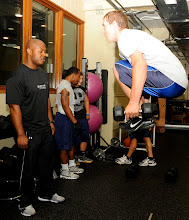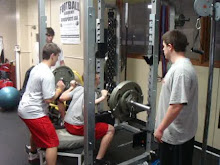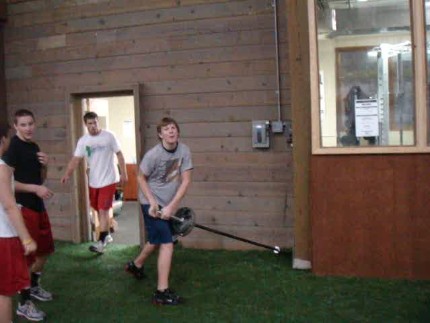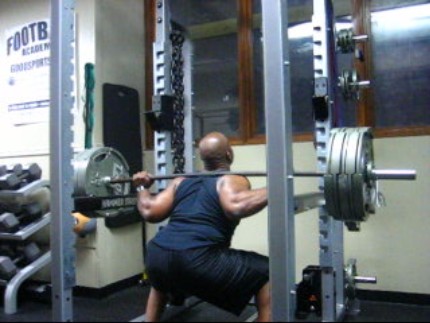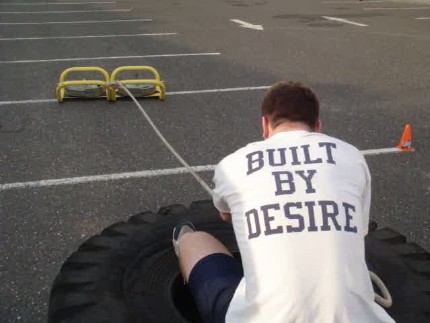| Steve's Amazing Story! | |
| It is a passion of mine to help people reach their goals and beyond. Everyday I spend hours upon hours on training, programming, counseling, designing, teaching & correcting just to name a few. More importantly I believe my job and my biggest responsibility is building! Building trust, confidence, better habits and better people. If I can make someone a better athlete that's great, but, if i can make you a better man or woman, that is the ultimate goal. I believe that life like athletics is about progressively building many qualities one after another on top of another, to achieve more! Every one of my clients leaves the program looking to achieve more...that's what life's all about. Along comes Steve. An ex-collegiate soccer player and a very competitive individual. Steve had become recently motivated because he was experiencing some threatening health issues. After expressing interest in training with me he came into my gym one day and just said, "Sign me up, when do we start!". Steve did not want to talk about changing, he was just ready to change. He had developed bone spurs in his shoulders and was having "other" problems with movement due to inflammation of his bursa sac. Along with this, his blood panel needed work as he was at an increased risk for heart disease and also heart attack. So Steve needed a complete overhaul. Well after a little over one month on the program I received this email (approximately July 15th)... Big Man, My wife just called to say the doctors office just called to give her my results. My first doctors appointment was April 15th, and about a week later I started taking a cholesterol drug called Simcor. That pill is expected to lower your cholesterol about 15% over time. It is niacin based so they say it will also help raise HDL and lower LDL levels. The bigger part of the equation is the drastic change in my diet and the exercise program I began with you on June 5th. The nurse that called with the results said they are astounded at not only the drastic change in my numbers, but by my physical appearance when they saw me on Monday, July 21. Roughly 3 months after my first visit I am about 21 pounds lighter and my lipid panel looks like this: Cholesterol went from 260 to 154 (under 200 is an acceptable number for them) HDL went from 38 to 44 (Acceptable is over 39) LDL went from 153 to 80 (Acceptable is less than 99) Triglycerides went from 345 to 135 (I think acceptable is under 150) Sugar went from 123 to 100 (still a little high, but she said there are 1000's of reasons it could be elevated a little) I have a follow up with the doctor on Monday morning. Needless to say, I am thrilled with the results, but by no means am I done. My cardio although better is obviously not where it needs to be. I'm doing better, but I know it's going to take a lot more work to be able to keep up with you young guys. I greatly appreciate all of your help and positive reinforcement. There is no way in the world I would have met my initial goal without your guidance. Steve In case you didn't know, I'm a strength junkie. I believe that people should be strong! I don't mean every one should bench press 400lbs or squat 600lbs (although for some that would be nice). I mean strong relative to YOUR body. Since muscles are what actually moves our skeletal system & everyone needs to maintain movement, strength can be very important. Well, Steve's strength level as gone up tremendously since our first session back on June 5th 2008. Our first session was more physical therapy than it was training. I had to get his body to understand movement patters all over again, so that's what we did. My approach with Steve was one of building confidence as well as bringing out of him what he already possessed. With that said, I left no stone unturned in helping Steve get the results he is looking for. My 1st week here Steve saw me wheeling in the big 600lb tire (typically reserved for our strongest athletes). He just looked and said, "Boy I'm long way off from flipping that!" Well with a little support, some increased confidence and a tail kicking program here is what Steve was able to accomplish.... | |
Friday, October 10, 2008
Client Chronicles
THE TRUTH ABOUT IN-SEASON TRAINING Pt. 1
This may lead us to many questions. Some of which are:
1. What does training in-season actually do?
2. What type of training should I do?
3. What if my schedule is undefined, how should I train then?
4. Will this make me more sore than I already am?
5. When is the best time to train?
Etc.
I have found that sports that are termed as "year round" sports are the sports that athletes have the lowest training participation. These sports like soccer, lacrosse and basketball, to name a few, are sports that athletes have unlimited access to play. They can go to any field, court or open lot and play a pick up game or work on some sport specific skill. In addition to their year round label, they also play TONS of games in virtually every season of the year. There schedules may have them playing 3 games one week and as many as 5 games the next. Sometimes they even play "double headers" engaging in multiple games in one day. These sports are really demanding on the athletes body and any moment to eat, rest & recover certainly should be maximized.
Then you have the controlled sports that don't have the means for athletes to play them year round. These sports require a certain amount of equipment or certain conditions that make it hard to play "pick up". Football, Ice Hockey & certain motor cross sports sports come to mind.
In either case the need for a solid training program is imperative! Just like a car needs its oil changed, maintenance checks and tune ups, athletes need in-season training. In this part of the article we'll discuss the philosophies on what in-season training should be built on.
Training in-season should be built on 4 things:
1. Injury prevention. Many athletes, especially those involved in contact sports, have to decrease their injury potential 1st and foremost. What good is any training program if you cant play? This calls for a lot of what is termed in the fitness community as pre-hab. This simply put is the idea that one may prevent injuries before they even happen with quality exercises designed to stabilize joint structure and increase sound movement patterns.
2. Muscle regeneration. Muscle regeneration is the idea that athletes need to be brought back to 100% before the next competition. I am not sure people realize how important muscle regeneration actually is. When an athlete is young they may have the ability to play 3 games in 3 days and have little to no carry over at all. As we age our ability to properly recover decreases. This IS trainable! The ability to be at 100% for every game is the biggest commodity for an athlete. Athletes need to know that they can train themselves to recover. As they progress through their season, their bodies will respond to the recovery methods. When this happens they can enjoy sustained success without production falling off late in the year. We utilize stretch ropes, foam rolls for myofascial tissue release and even yoga & ice to help athletes bring there bodies back to game condition.
3. Muscle strength. Yup, I said it. I want athletes to get stronger DURING THE SEASON. Now, when I say that I don't mean I want to put them under a ton of stress and certainly not under maximal weights. I am just addressing that fact that athletes can add to their strength gains if they train properly. Athletes should lift lighter weights for lower volumes than off-season training programs while keeping the intensity high. Effort should always remain high! They should also engage in a lot of body weight movements. Exercises like push-ups, dips, pull-ups, sit-ups and body squats are excellent for keeping strong and not adding too much stress on the nervous system.
4. Nutrition & Rest. This is just as important as the rest of the items I've discussed. Athletes need to consider their eating habits training. Likewise they should also treat their resting habits as training. This approach will almost assure any athlete that they are eating correctly and sleeping enough. When these two elements are considered important, extraordinary results are achieved.
Athletes who engage in year round sports have the challenge of trying to develop their bodies while they are constantly breaking them down. All of your training is in-season. This is why I recommend that all athletes take seasonal breaks from their sport to allow time for proper training and to restore their bodies. I feel that your training should be done 2-3 days prior to competition if at all possible. Remember that relative body strength and muscle restoration will take you a long way. Get your training in every week without fail. When you have additional time or a down week, train harder and rest as much as possible. You should also consider training around the same time of day as your practices and competitions. This will keep your body regulated and hopefully allow your nutrition to remain relatively simple. You must consider the work it takes to be the best not only happens on the field, but off of it too.
Athletes who have followed a full off-season training program need to maintain their gains in-season. Your programs should be very high in intensity and a bit shorter in duration. Restorative work is always great but the main objective is to keep from breaking down and getting injured. Center your program around the basics. Your program does not need to be fancy, just stick to the basic structural exercises (squats, bench press & pull-ups) and get out of there. Your performance will benefit from the training aiding against muscle breakdown and extreme weight loss.
I feel the need to address two common issues.
1) Some athletes spend too much time in the weight room. They cannot differentiate between off-season training and in-season. Well, don't spend a lot of extra time in the weight room. Workouts should be closer to 45 min long and medium to high intensity. The object is to push yourself. Once the task is completed, go home. Staying for extra bicep work is not necessary at this point. Besides, spring break is still a few months away anyway.
2) If you aren't playing much you should be training a bit more. Although you practice and are involved in the sport itself, you may not be taking full advantage of your ability to get better. Add an extra day of training to your regimen. This will keep you ready late in the season should injuries occur and even allow you to get the jump start on next year.
There is much more to consider when training in-season. In our next installment we'll discuss typical mistakes with in-season training and sample training programs to help assist you in your knowledge about the truth on in-season training. Thanks!
Practical Health Tips...

Everybody is an expert now-a-days! Especially when it comes to nutrition. People have been inundated with the "how to's" of nutrition and other sorts of expert advise. For my readers, I'm sure most of you eat a somewhat clean diet full of protein and vegetables and healthy sources of essential fats and so on, right? Riiiight! The reason you keep hearing people like me say eat this and eat that is because...YOU AREN'T DOING IT YET! At least the ones who should be aren't. So, with that said, hear this again for the 1st time!
My coach once told me that if I wanted C's all I had to do was go to class. If I wanted B's I would have to listen in class. And, if I wanted A's I'd have to apply myself beyond just being there and listening. Now we know that good grades aren't just handed out but they have to be earned. So coach's point was basically this. A little effort will get you mediocrity, a little more than that will get you average. But, it would take a lot of effort if you wanted to be great. Well the same holds true for our nutrition. The problem is that people get so infatuated with the end result they forget all the little things that help them get there. People start out and say " I want to lose 20lbs by next month". They begin this impossible dieting and psych themselves up to do something they know in their heart of hearts they aren't going to finish. Reason is because they have no plan. A diet is a lifestyle change, PERIOD. To be successful you must have a weekly goal, a short term goal (2-4 months) and a annual goal. These goals should be under constant evaluation to ensure their effectiveness. But before we can have the house we must lay the foundation. So for today's discussion we're going to start shooting for C's.
Here are some basic's of a well rounded diet and I hope they inspire you through common sense to take the challenge to get fit. The fact of the matter is we, as a country, are well below average health wise. So here it goes....listen up you just might hear something you've only heard 1,500 times before! Ha...
Step 1. Protein in King! It all begins here. You should shoot for approximately 20g per meal. If you are eating a clean diet that's loaded with protein and good vitamin sources then the "how many grams per meal" question will become clearer once weight starts going down. With protein we want to reduce craving for "bad" carbs, retain muscle and and recover after workouts. Lack in this area will lead to problems down the road, so eat up.

*Eating clean (staying away from bad fats and sugars & replacing them with quality proteins, carbs & fats) will help speed the metabolism causing you to become hungry faster. So that will explain why you're probably eating more. Embrace it! Bad food has a tendency to satiate you much more thus slowing down metabolism and increasing carbohydrate cravings.
Step 2. Eat more vegetables! This can't be any clearer. Vegetables can be eaten at any time and practically as much as you want. They will greatly increase your energy levels as they aid in vitamin regulation, supply good carbohydrates, are rich in minerals and enzymes & make you more alkaline. Eat them raw, cooked, organic and any other way you can think of. Eat green, red, yellow & purple. However, there are some you must avoid if you have thyroid issues. Check with your nutritionist for details.

"eat one of these a day"
Step 3. Take a multi-vitamin. Some vitamins are fat soluble and some are water soluble. In order to ensure you are getting the most from your body I recommend a good multi-vitamin (usually in liquid form) to help maintain a healthy lifestyle.

Step 4. Increase essential fatty acids. Fats are good. Too many of the wrong type is bad. Essential fats like Omega-3 & 6 fish oil helps us increase our metabolism, control cravings and lose excess weight.

So, there is is. Simple right? If you begin to incorporate these simple techniques into your diet you will see great results and drop pounds like never before. Now I must say that results may vary. If you have medical considerations please seek professional help. Additionally, these factors are generalized techniques and are not intended to treat or cure anything. A workout routine is highly recommended and will greatly increase effectiveness.
We'll be back soon to discuss the way in which to apply these into your day.
My coach once told me that if I wanted C's all I had to do was go to class. If I wanted B's I would have to listen in class. And, if I wanted A's I'd have to apply myself beyond just being there and listening. Now we know that good grades aren't just handed out but they have to be earned. So coach's point was basically this. A little effort will get you mediocrity, a little more than that will get you average. But, it would take a lot of effort if you wanted to be great. Well the same holds true for our nutrition. The problem is that people get so infatuated with the end result they forget all the little things that help them get there. People start out and say " I want to lose 20lbs by next month". They begin this impossible dieting and psych themselves up to do something they know in their heart of hearts they aren't going to finish. Reason is because they have no plan. A diet is a lifestyle change, PERIOD. To be successful you must have a weekly goal, a short term goal (2-4 months) and a annual goal. These goals should be under constant evaluation to ensure their effectiveness. But before we can have the house we must lay the foundation. So for today's discussion we're going to start shooting for C's.
Here are some basic's of a well rounded diet and I hope they inspire you through common sense to take the challenge to get fit. The fact of the matter is we, as a country, are well below average health wise. So here it goes....listen up you just might hear something you've only heard 1,500 times before! Ha...
Step 1. Protein in King! It all begins here. You should shoot for approximately 20g per meal. If you are eating a clean diet that's loaded with protein and good vitamin sources then the "how many grams per meal" question will become clearer once weight starts going down. With protein we want to reduce craving for "bad" carbs, retain muscle and and recover after workouts. Lack in this area will lead to problems down the road, so eat up.
*Eating clean (staying away from bad fats and sugars & replacing them with quality proteins, carbs & fats) will help speed the metabolism causing you to become hungry faster. So that will explain why you're probably eating more. Embrace it! Bad food has a tendency to satiate you much more thus slowing down metabolism and increasing carbohydrate cravings.
Step 2. Eat more vegetables! This can't be any clearer. Vegetables can be eaten at any time and practically as much as you want. They will greatly increase your energy levels as they aid in vitamin regulation, supply good carbohydrates, are rich in minerals and enzymes & make you more alkaline. Eat them raw, cooked, organic and any other way you can think of. Eat green, red, yellow & purple. However, there are some you must avoid if you have thyroid issues. Check with your nutritionist for details.
"eat one of these a day"
Step 3. Take a multi-vitamin. Some vitamins are fat soluble and some are water soluble. In order to ensure you are getting the most from your body I recommend a good multi-vitamin (usually in liquid form) to help maintain a healthy lifestyle.
Step 4. Increase essential fatty acids. Fats are good. Too many of the wrong type is bad. Essential fats like Omega-3 & 6 fish oil helps us increase our metabolism, control cravings and lose excess weight.
So, there is is. Simple right? If you begin to incorporate these simple techniques into your diet you will see great results and drop pounds like never before. Now I must say that results may vary. If you have medical considerations please seek professional help. Additionally, these factors are generalized techniques and are not intended to treat or cure anything. A workout routine is highly recommended and will greatly increase effectiveness.
We'll be back soon to discuss the way in which to apply these into your day.
Subscribe to:
Comments (Atom)
